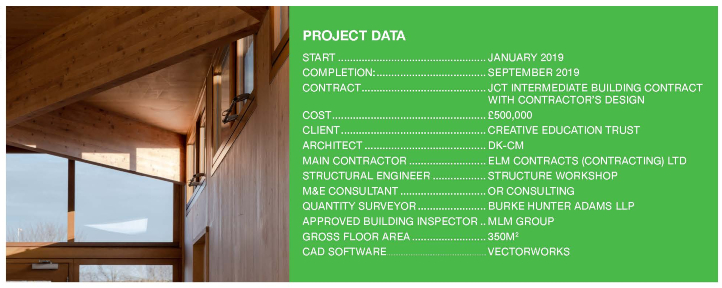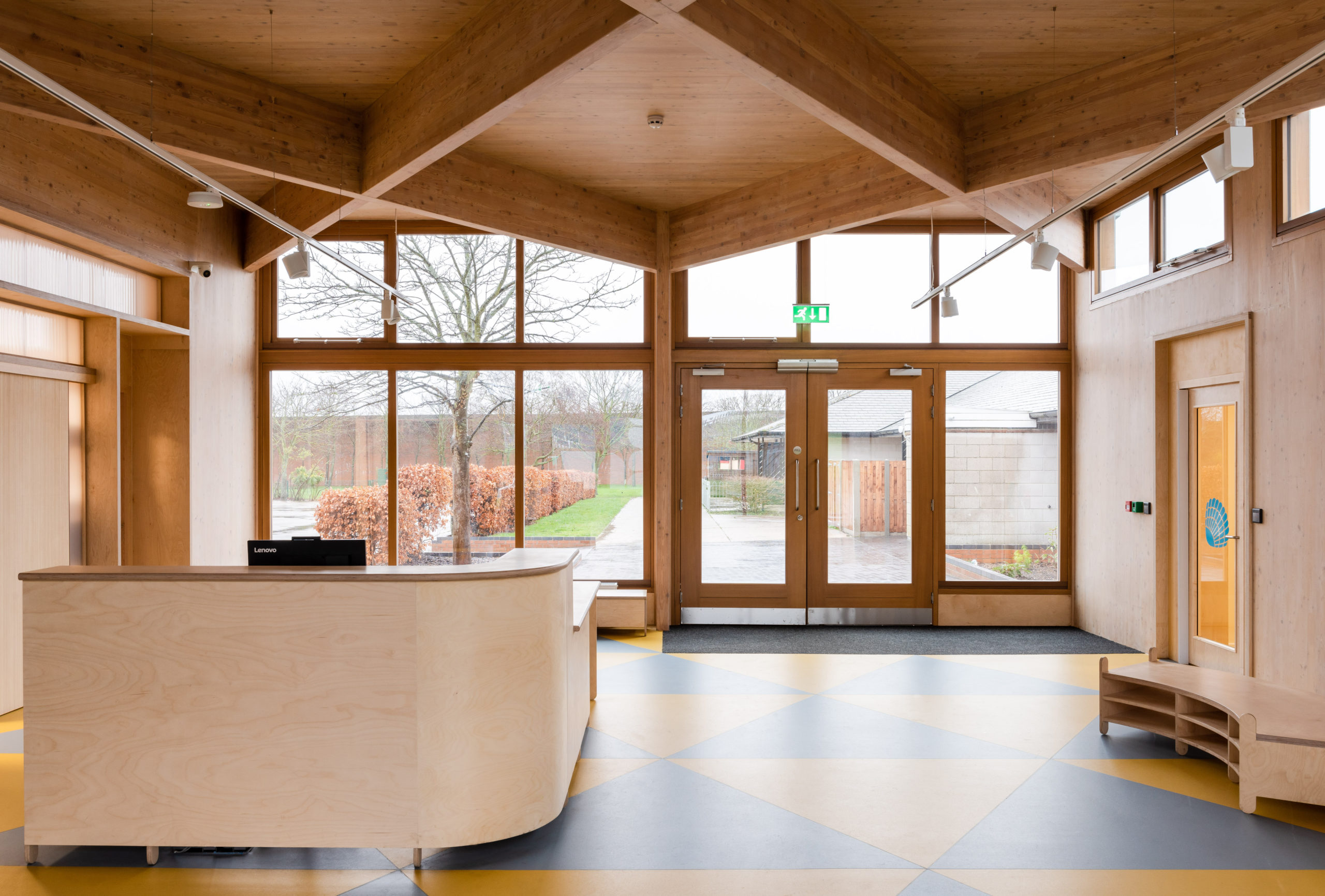The site of Wroughton Academy in Gorleston, Great Yarmouth, was for many years shared by separate junior and infant schools. Having come under the same management recently, a project was commissioned to create a cross-laminated timber (CLT) structure to link the two buildings. A JCT Intermediate Building Contract with contractor’s design was the form of choice.
The new CLT building symbolises the merging of the two schools under the Wroughton Academy umbrella by providing a new front and central focus point to the school, securely linking the two existing campuses. The building itself houses the new reception for both schools, a generous front of house space which can be configured flexibly for presentations, informal teaching, exhibitions, etc., and office and meeting rooms for the school’s support staff. Combining the two campuses with this linked space is designed to help develop a greater sense of community by enabling infant and junior pupils to meet and learn together.
In order to deliver the project successfully, the project team had to fulfil a number of important objectives: to create an environment of which the school children would have a sense of ownership, to respect the existing architecture of the site so that it fits seamlessly, but also has its own distinct identity and is functional, and finally, not to impact the day-to-day running of the school.
In terms of design, the inserted building takes the majority of its cues from the 1950s original brick and concrete junior school, reflecting the same modernist, open-air principles. Core features of the movement include sun lighting, fresh air, generous open space, and exposure to the outside. The warm timber and large windows present an atmosphere and openness that are more akin to public buildings such as libraries or museums and integrates this into the ordinary daily life of the school. In addition, the structure was sited to retain the existing green landscape.
The open-air principles are continued with the use of raking cross walls to form the bays of the block’s glazed frontage. The use of CLT provides a distinctive look against the original buildings, but its neutral canvas and sympathetic design references also enable it to merge between the two building’s separate designs. For example, the softer timber links to the pitched roof blocks of the 1990s infant school.
The defining feature of the interior is the expressed diagrid timber, 4-metre high, structure across the ceiling in the reception area. The triangle/diamond shapes are also mirrored in the flooring, with the grey/blue and canary yellow patterning that is used. The colour and texture of the CLT dominates the interior space with the exposed walls, wooden framing of the glazed facades and clerestory windows, as well as the timber reception desk and movable benches. The warmth and neutrality of the timber comes into play once again, making the space suitable and functional for a variety of purposes.
The function of the building has been informed in part through a series of workshops and consultations that involved the children themselves. This involved the children testing and playing within the space and addressing issues such as where the reception should be placed and the patterns for the internal structure and floor. With older students, the focus was on learning and inclusiveness to make the students feel a sense of ownership. Workshops explored the modern methods of construction used and the importance of sustainability for our future. At the completion of the project, an opening ceremony was held where the students cut the ribbon.
The consultation process has led to the development of a highly configurable space that can be adapted to suit a number of different purposes. For example, the movable benches can be used either as a reception space linking the two schools or can be arranged auditorium-style to be used as a teaching space.
A key benefit of the construction process, in particular the use of CLT, was the ability to use extensive off-site construction methods. It reduced both the construction period and the amount of waste. Using modular construction also meant that, once delivered to site, the CLT and Glulam frame could be assembled quickly, enabling the school to remain open and operational throughout the build phase, with the impact on normal activity being minimised as much as possible.
CLT was also an important choice for its sustainable credentials, an important consideration from perspective of the architect’s philosophy, which looks to maximise on building performance whilst minimising the impact on the world’s finite resources, and for the pupils, where the use of CLT construction brings well-being benefits – a breathable and comfortable internal climate to help reduce stress and improve cognitive function.
The use of the JCT Intermediate Building Contract with contractor’s design provides a reliable option for a project of this nature. The JCT Intermediate Building Contract is specifically designed for projects where there is some level of complexity and where detailed design and drawings will be required in advance. This enables the project team to decide on material choice and construction method, specifically the use of offsite construction, and to carry out the necessary consultation process to inform the design. The contractor’s designed portion is particularly useful to provide the necessary flexibility for the completion of works on site.

Images: Neil Perry

